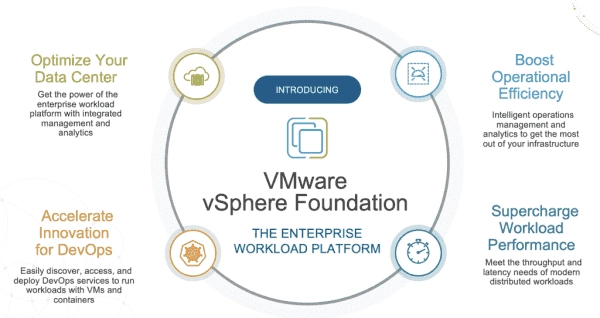Expanding beyond its original x86 virtualization offerings, VMware has grown into a software provider for the enterprise with products for software-defined networking (NSX), hyper-converged infrastructures (vSAN), and container infrastructure. Nevertheless, the company also maintained a range of offerings for smaller environments.
Broadcom’s repositioning of VMware primarily targets big corporate customers, aiming to help them utilize the entire VMware stack included in VMware Cloud Foundation. Users of the previous vSphere Enterprise Plus edition can transition to vSphere Foundation alternatively.
It includes various features that would be welcomed in smaller environments, such as VM encryption or Distributed Resource Scheduler (DRS). However, this edition includes numerous components that smaller and medium-sized enterprises rarely need and require a significant surcharge (see the details).
Thinning out in the lower segment
In the past, there were several options for the SMB market. Individual hosts could utilize the free vSphere Hypervisor, and VMware also offered two editions designed for smaller businesses (Essentials and Essentials Plus). Additionally, three ROBO editions were primarily intended for branch offices and licensed based on the number of VMs.
With the discontinuation of ESXi Free and vSphere Essentials, Broadcom has excluded small environments that need an affordable solution for basic virtualization functions. The manufacturer now specifically targets SMEs with the Essentials Plus Kit.
Standard Edition versus Essentials Plus Kit
For medium-sized businesses, the Standard Edition is also worth considering. It offers significantly more features and includes vCenter Standard, which can manage up to 4000 hosts. In contrast, vCenter Essentials can only be used with the Essentials Plus Kit.
The key benefits of the Standard Edition include management automation features, such as the vSphere Lifecycle Manager introduced with vSphere 7, including the Update Planner and Server Profiles. Fundamental features like support for TPM 2.0 or Virtualization-based Security in Windows guests are also included, while unavailable in vSphere Essentials Plus.
Licensing
One of the initial actions Broadcom undertook was to terminate perpetual licenses and embrace full subscriptions. Those customers who have active support contracts are given a grace period until their renewal, with Broadcom even presenting alternatives for early exchange
Unavoidably, every customer should brace for a surge in costs when employing VMware products. Due to the new billing method now being strictly per core rather than CPU, drawing a thorough comparison with the previous pricing regime would pose a challenge. The costs are therefore significantly contingent on the respective environments.
Cost comparison: Old versus new
As a reference point, various offers based on the old licensing model that still exist on the web can be considered. The following figures provide only a rough indication based on a fictional environment, so direct conclusions regarding cost increases for one’s own company cannot be drawn from them.
For instance, the Standard Edition with a perpetual license, as reported by R//C, costed 1394 USD per CPU with one year of support, which was limited to 32 cores. Under the new model, VMware calculates 59.99 USD per core and year, resulting in a total of 1,919.68 USD for a host with a 32-core CPU. The price for three years is 127.99 USD per core (several price information has been taken from Insight’s website before the company removed all vSphere subscriptions).
With a five-year SnS contract, the ratio for the same configuration amounts to 2,672.99 USD (perpetual) compared to 6,815.68 USD (212.99 USD per core subscription).
Evidence of the old license costs can still be found in some Web-shops.
Overpayment due to per-core licensing
One reason for this is that licensing per core involves additional pitfalls. For example, a minimum of 16 cores must be licensed per processor, even if it has fewer cores. There is a similar requirement for Windows Server, but at least 16 cores per server, not per processor, must be licensed with Microsoft.
The Essentials Plus Kit presents a particularly high risk of overcommitment. Here, you always purchase a license for 96 cores, which can be distributed across a maximum of three ESXi hosts. These costs amount to 4,088.99 USD for one year, 8,585.99 USD for three years, and 14,308.99 USD for five years.
Standard Edition often cheaper than Essentials Plus Kit
However, many smaller environments do not fully utilize such a license. For example, if they use three hosts, each with a CPU containing 16 cores, the total configuration has 48 cores.
As one can easily calculate, in this case, the Standard Edition would be cheaper and includes more features. The above prices would amount to 2,879.52 USD for a one-year subscription and 10,223.52 USD for five years.
Here is an overview of the sample calculation for three hosts, each with a 16-core CPU (48 CPU cores in total):
| 1 Year | 3 Years | 5 Years | |
| Essentials Plus Kit | 4,088.99 $ | 8,585.99 $ | 14,308.99 $ |
| Standard Edition | 2,879.52 $ | 6.143,52 $ | 10,223.52 $ |
It stands critical to leverage the existing setup along with future plans of one’s infrastructure for computing needs. It allows for making an informed choice between different versions.
Summary
The consolidation of product range and shift to core-based subscription licensing acts as a game-changer for all VMware users. Be it a small firm or a large one, they are likely to face substantial added expenses.
Given that the new management’s attention is primarily on the enterprise market, small businesses are at a loss as the services they rely on are getting shelved. It predominantly impacts the Essentials Edition and the vSphere Hypervisor.
Subscribe to 4sysops newsletter!
One level above, Broadcom still offers the vSphere Essentials Plus Kit, but due to its rigid licensing for 96 cores, it may be more expensive in some environments than the Standard Edition.
